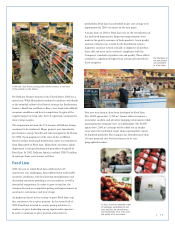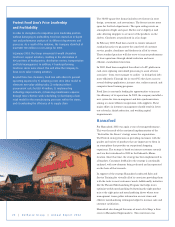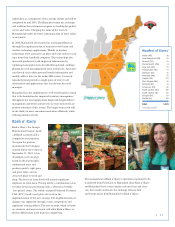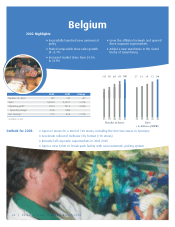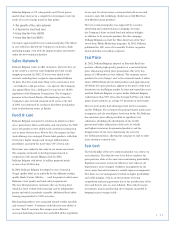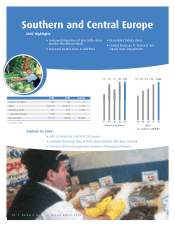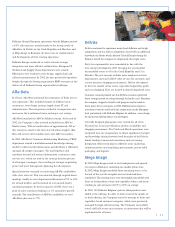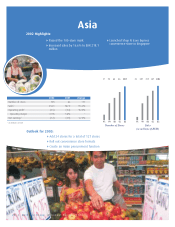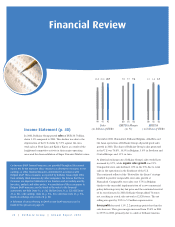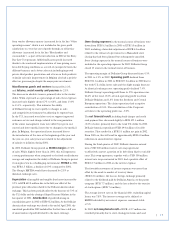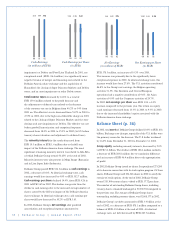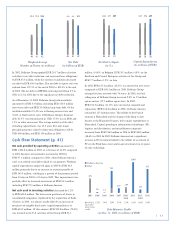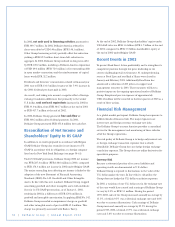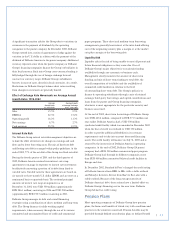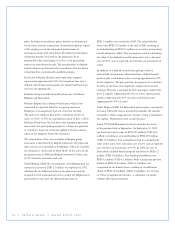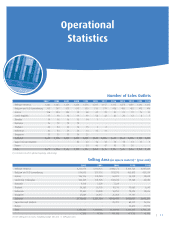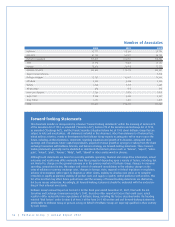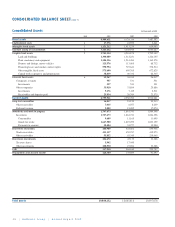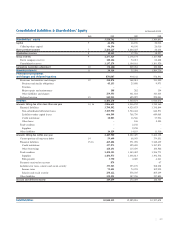Food Lion 2002 Annual Report Download - page 31
Download and view the complete annual report
Please find page 31 of the 2002 Food Lion annual report below. You can navigate through the pages in the report by either clicking on the pages listed below, or by using the keyword search tool below to find specific information within the annual report.
|29
from vendor allowance money (accounted for in the line “Other
operating income”, which is not included in the gross profit
calculation) to every day cost of goods through an off invoice
allowance (accounted for in the line “Merchandise and
consumables”), as part of the introduction in 2002 of the Every
Day Low Cost program. Additionally, gross profit increased
thanks to the continued implementation of zone pricing, more
favorable buying conditions as a result of synergies between the
different banners, and a better sales mix including improved
private label product penetration and a focus on fresh products.
A similar sales mix improvement in Belgium also had a positive
effect on gross margin despite the major price investments.
Miscellaneous goods and services decreased by 2.2%,
and Salaries, social security and pensions by 2.5%.
The decrease in absolute terms is primarily due to the weaker
dollar. When expressed as a percentage of sales, these expenses
increased only slightly (from 6.7% to 6.8%, and from 13.0%
to 13.1%, respectively). This indicates the ability
of Delhaize Group to react rapidly to changes in sales
and competitive environment by adjusting its expense base.
In the U.S., increased store labor costs to support improved
customer service and charges related to the reorganization
of the senior management team were offset by rigor in cost
control and lower medical costs due to changes in the medical
plan. In Belgium, the operational costs increased due to
the introduction of the euro at the beginning of the year and
the year-on-year salary increases related to the adjustment
of salaries to inflation during 2001.
In 2002, Delhaize Group posted an EBITDA margin of 7.4%
of sales. While slightly lower than in 2001, this still represents
astrong performance when compared to the food retail industry
average and emphasizes the ability of Delhaize Group to protect
its margins even in a challenging environment. EBITDA in 2002
was EUR 1.5 billion, a decline of 6.9% compared to 2001.
The Group’s EBITDA would have decreased by 2.5% at
identical exchange rates.
Depreciation of intangible and tangible fixed assets increased by
0.5% to EUR 632.8 million due to the full-year effect of the
purchase price allocation related to the Delhaize America share
exchange. This has been partially offset by the decrease of 5.3% of
the U.S. dollar and the closing of Super Discount Markets in the
last quarter of 2001. Amortization of goodwill arising on
consolidation grew in 2002 to EUR 92.2 million. As the Delhaize
America share exchange was closed at the end of April 2001, the
amortized goodwill in 2002 included for the first time a full year
of amortization of goodwill related to the share exchange.
Store closing expenses in the normal course of business were
down from EUR 8.5 million in 2001 to EUR 3.0 million in
2002, including a favorable adjustment of EUR 6.9 million
related to the release of a provision for a Hannaford store
closing that had been planned but subsequently cancelled.
Store closing expenses in the normal course of business were
included in the operating expenses. In 2002, Delhaize Group
closed 15 stores in the normal course of business.
The operating margin of Delhaize Group decreased from 4.3%
in 2001 to 3.9% in 2002. Operating profit declined from
EUR 921.3 million in 2001 to EUR 807.2 million in 2002 due to
the weak U.S. dollar, lower sales and the slight margin decrease.
At identical exchange rates, operating profit declined 7.9%.
Delhaize Group’s operating profit from its U.S. operations was
86.6% of the total; 15.2% of total operating profit was from
Delhaize Belgium and 1.8% from the Southern and Central
European operations. The Asian operations had a negative
contribution of 0.6%. The contribution of the Corporate
activities to the operating profit was –3.0%.
The net financial result,including bank charges and credit
card payment fees, decreased slightly to EUR 455.1 million
(2.2% of sales), primarily due to the weak U.S. dollar. In 2002,
Delhaize America repurchased USD 69.0 million of its debt
securities. That resulted in a EUR 5.1 million net gain in 2002.
From 2003 on, this will result in approximately EUR 6.0 million
reduction in annual interest expense.
During the third quarter of 2002, Delhaize America entered
into a USD 200 million interest rate swap agreement
to effectively convert a portion of its debt from fixed to variable
rates. This swap agreement, together with a USD 300 million
interest rate swap contracted in 2001, had a positive effect of
EUR 12.7 million in 2002 on the interest expense.
The favorable movement of interest expenses was more than
offset by the mark to market of treasury shares
(EUR 12.6 million), the loss on foreign exchange primarily
related to the dividend paid by Delhaize America to the parent
company (EUR 7.7 million), and the loss related to the exercise
of stock options (EUR 7.6 million).
The average interest rate on the financial debt, excluding capital
leases, was 7.8%. The interest coverage ratio, defined as
EBITDA divided by net interest expenses, remained stable
at 3.8.
In 2002, net exceptional result of EUR –12.7 million was
recorded primarily due to store closing provisions and asset


